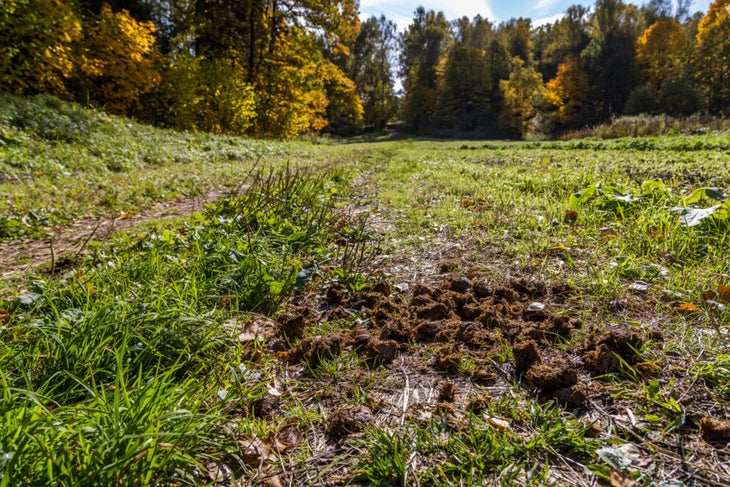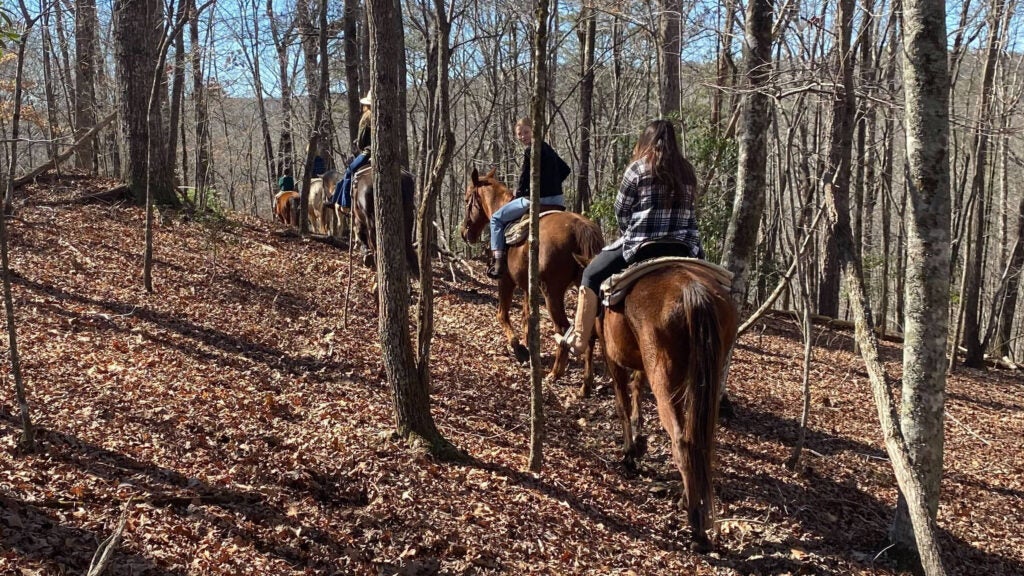“], “filter”: { “nextExceptions”: “img, blockquote, div”, “nextContainsExceptions”: “img, blockquote, a.btn, a.o-button”} }”>
Heading out the door? Read this article on the new Outside+ app available now on iOS devices for members!
>”,”name”:”in-content-cta”,”type”:”link”}}”>Download the app.
If you’ve ever hiked on a trail shared by horseback riders, you’ve likely come across manure in some state of decay. For most hikers, it’s a minor nuisance. But for others, these “road apples” represent a perceived double standard: How come equestrians can leave poop on the ground when we hikers carry out ours and our dogs’?
The discussion has sparked debates online from hikers, bikers, and runners who are sick of dodging piles of poo on the trail. Some argue that equestrians should have to follow the same standards as hikers and dog owners. But that apples to apples comparison may not be a fair one.
Just like hikers, backcountry equestrians adhere to Leave No Trace (LNT) standards that are specific to their mode of recreation. Horse packing and backpacking differ in a lot of ways, including etiquette around handling poop—that’s because horse poop and human or dog poop aren’t the same.
Equestrian etiquette generally mandates that riders remove manure from high-traffic areas like trailheads, and scatter it whenever possible in the backcountry, especially on multi-use trails. In their online Stock Use Course, LNT recommends dispersing manure piles when leaving camp and after rest breaks.
“In general, it is considered polite for anyone using stock on multi-use trails to continue the practice of scattering manure when feasible. This is generally done by use of their boot,” said Craig Ferdig, Vice Chairman of the Back Country Horsemen of America.
But according to Ferdig, it is sometimes difficult or impossible for riders to do so. In areas where it’s dangerous for a rider to dismount or remount, they may leave manure on the trail. In other instances, an equestrian might not be aware that their horse has defecated.
“Some horses walk on with no indication anything is happening,” he said.
Unlike dog or human feces, horse manure breaks down in a few days, and in some cases may even provide valuable nutrients to the soil, according to Ferdig. Scattering can expedite this process. According to the National Park Service, horse manure, which contains mostly digested plant matter, is unlikely to spread disease in the same way human or dog feces might. Sunlight kills bacteria such as E. coli, further reducing the risk to hikers.

“Human and dog waste can carry harmful pathogens (like E. coli, Giardia, or parasites) that are transmissible to humans and wildlife,” said JD Tanner, Director of Education and Training at LNT. “This is why they need to be packed out or buried properly away from water sources, unlike horse manure, which typically poses a lower health risk.”
One exception? Manure containing ivermectin residue from a horse that has recently been de-wormed can pose a hazard to dogs if ingested. While instances of poisoning from eating manure is rare, keep an eye on your dog if you’re hiking on a trail where manure is present.
According to Tanner, practicality also comes into play when considering the differences in etiquette for equestrians and hikers. On long rides, it’s simply impractical for riders to carry out manure
“Instead, spreading or moving it off-trail ensures that it can decompose without being an obstacle to other users,” Tanner said.
Manure may be a fact of life on some multi-use trails, but hikers can rest assured that it doesn’t pose a health risk. As for the gross factor? Plenty of trails are closed to horses—though you may be just as likely to stumble upon bear, moose, or coyote scat. This is nature, after all.
Tips for enjoying multi-use trails
Ferdig encourages hikers who encounter horses and riders on the trail to smile and talk—avoid hiding behind trees, which could fool a horse into thinking you’re a predator.
“Talking actually helps the horse realize [you are] a person, not a predator,” he said. “They don’t understand what a backpack is, all they see is a potential predator.”
Keep your distance from horses on the trail and only approach with permission from the owner.
And if you come across a steaming pile of manure?
“Simply stepping around manure helps avoid conflicts with other trail users and prevents unnecessary trail widening, which can happen if people go off-trail to avoid obstacles,” Tanner said.
In areas where manure is causing a significant impact to hikers, Tanner says trail users can notify land managers or trail maintenance crews, who will assess the situation.
